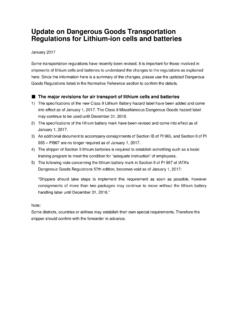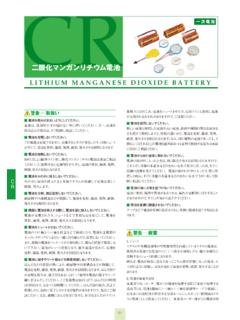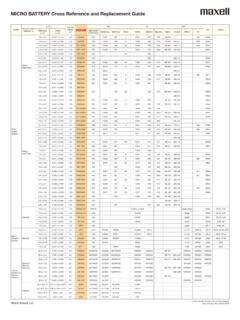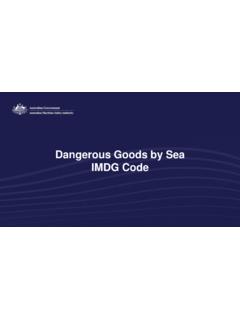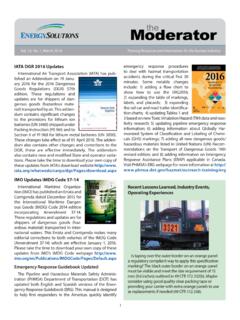Transcription of Update on Dangerous Goods Transportation Regulations for ...
1 36 Update on Dangerous Goods Transportation Regulations for Lithium Cells and BatteriesJanuary 2018 Some Transportation Regulations have recently been revised. It is important for those involved in shipments of lithium cells and batteries to understand the changes to the Regulations as explained here. Since the information here is a summary of the changes, please use the updated Dangerous Goods Regulations listed in the Normative Reference section to confirm the details. Technical instructions for lithium metal batteries (PI 968)SectionSection IISection IBSection IALithium Metal ContentCell: gBattery: gCell: gBattery: gCell: gBattery: gCell: > gBattery: > gPackage LimitsQuantityNo limit 2 batteries or 8 cells> 2 batteries or > 8 cellsNo limitNet WeightCargo aircraft kgCargo aircraft onlyN/ACargo aircraft kgCargo aircraft only35 kgQuantity of Package per ConsignmentNo more than 1No limitClassificationExemptedClass 9 PackagingStrong rigid outer m drop testUN specification packagingLabels(see drawing on following page)Cargo aircraft only labelLithium battery markCargo aircraft only labelLithium battery markLithium battery hazardous labelCargo aircraft only labelLithium battery hazardous labelDocumentsAir waybill*1 Declaration for DGAir waybill*2 Declaration for DGAir waybill*2 TrainingEstablishment of documented procedures.
2 Learning and reviewing these procedures, and maintaining training of DG training and test*1 The words Lithium metal batteries in compliance with Section II of PI 968 and Cargo Aircraft Only or CAO must be included on the air waybill, when an air waybill is used. The information should be shown in the Nature and Quantity of Goods box of the air waybill.*2 The words Dangerous Goods as per attached Shipper's Declaration and Cargo Aircraft Only or CAO must appear in the air waybill's "Handling Information" instructions for lithium-ion batteries (PI 965)SectionSection IISection IBSection IAWatt HourCell: WhBattery: WhCell: 20 WhBattery: 100 WhCell: 20 WhBattery: 100 WhCell: > 20 WhBattery: > 100 WhState of Charge (SOC)Not exceeding 30% of rated capacityPackage LimitsQuantityNo limit 2 batteries or 8 cells> 2 batteries or > 8 cellsNo limitNet WeightCargo aircraft kgCargo aircraft onlyN/ACargo aircraft only10 kgCargo aircraft only35 kgQuantity of Package per ConsignmentNo more than 1No limitClassificationExemptedClass 9 PackagingStrong rigid outer m drop testUN specification packagingLabels(see drawing below)Cargo aircraft only labelLithium battery markCargo aircraft only labelLithium battery markLithium battery hazardous labelCargo aircraft only labelLithium battery hazardous labelDocumentsAir waybill*3 Declaration for DGAir waybill*4 Declaration for DGAir waybill*4 TrainingEstablishment of documented procedures.
3 Learning and reviewing these procedures, and maintaining training of DG training and test*3 The words Lithium-ion batteries in compliance with Section II of PI 965 and Cargo Aircraft Only or CAO must be included on the air waybill, when an air waybill is used. The information should be shown in the Nature and Quantity of Goods box of the air waybill.*4 The words Dangerous Goods as per attached Shipper's Declaration and Cargo Aircraft Only or CAO must appear in the air waybill's "Handling Information" aircraft only labelLithium battery mark* Place for UN number(s)** Place for telephone number for additional informationLithium battery hazardous label<Drawings of labels> The major revisions for air transport of lithium cells and batteries1) The specifications of the new Class 9 Lithium Battery hazard label have been added and come into effect as of January 1, 2017. The Class 9 Miscellaneous Dangerous Goods hazard label may continue to be used until December 31, ) The specifications of the lithium battery mark have been revised and come into effect as of January 1, ) An additional document to accompany consignments of Section IB of PI 965 and PI 968, and Section II of PI 965-PI 970 are no longer required as of January 1, air Transportation , the minimum requirements to transport lithium cells and batteries as exempted from class 9 Dangerous Goods (non-restricted Goods ) are as follows:1) Cells and batteries shall be manufactured under a quality management ) For a lithium metal cell, the lithium content is not more than 1 g.
4 For a lithium metal battery, the aggregate lithium content is not more than 2 g. For a lithium-ion cell, the Watt-hour rating is not more than 20 Wh. For a lithium-ion battery, the Watt-hour rating is not more than 100 Wh. The Watt-hour rating must be marked on the outside of the battery case except for batteries manufactured before January 1, ) Each cell or battery must be of the type proven to meet the requirements of each test in the UN Manual of Tests and Criteria, Part III, sub-section ) Cells shall be packed in inner packaging that completely encloses the cell. The inner packaging shall be packed in strong rigid outer ) A lithium battery mark must be marked on each package. A UN number and a telephone number must be placed on the mark for additional information. 6) Each package must be capable of withstanding a m drop ) Except when batteries are installed in or packed with equipment, packages shall not exceed 30 kg gross will provide certificates for 2) and 3) as the need arises.
5 Documentation for 4) and 5) needs to be prepared by the customer. If our package is used for transport, Maxell will provide the certificate for 6) as the need arises. However, if the customer s package is used, the customer must confirm the package can withstand a m drop test. Furthermore, even if our package is used for transport, the telephone number printed on the mark must be changed to that of the sender (customer).Normative ReferencesMajor applicable Regulations for the Transportation of lithium cells and batteries are as follows:UN (United Nations) Recommendations (Air, Marine, Overland Transportation ) UN (United Nations): Recommendations on the Transport of Dangerous Goods : Model Regulations 19th revised edition UN (United Nations): Recommendations on the Transport of Dangerous Goods : Manual of Tests and Criteria 6th revised edition Air Transportation ICAO ( international Civil Aviation Organization): Technical Instructions for the Safety Transport of Dangerous Goods by Air 2017-2018 edition IATA ( international Air Transport Association): Dangerous Goods Regulations 59th editionMarine Transportation IMO ( international maritime Organization).
6 international maritime Dangerous Goods ( imdg ) code 2016 edition The major revisions for UN Model Regulations 19th Revised Edition1) The specifications of the new Class 9 Lithium Battery hazard label have been added and come into effect as of January 1, 2017. The Class 9 Miscellaneous Dangerous Goods hazard label may continue to be used until December 31, ) The specifications of the lithium battery mark have been revised and come into effect as of January 1, 2017. The provisions concerning marking in SP 188 of 18th revised edition may continue to be applied until December 31, ) An additional document to accompany consignments in SP 188 is no longer required as of January 1, imdg code 2016 edition will contain the descriptions of these UN recommendations. The voluntary compliance date is January 1, 2017. Compliance becomes mandatory on January 1, 2018. Although the Regulations for land Transportation in each country are based on UN recommendations, some districts, or countries may establish their own special requirements.
7 Therefore the shipper shall confirm with the forwarder in CATALOG(E) MXL-E1801 Printed in JapanMaxell, Ltd. Energy DivisionVisit our website at: contents accurate as of January and dimensions are just reference on this catalog are subject to change without notice. Committed to the highest quality assurance management standards as well as responsibility to the is accredited with international quality management standard ISO 9001 and international environmental management standard ISO 14001 certifications.
